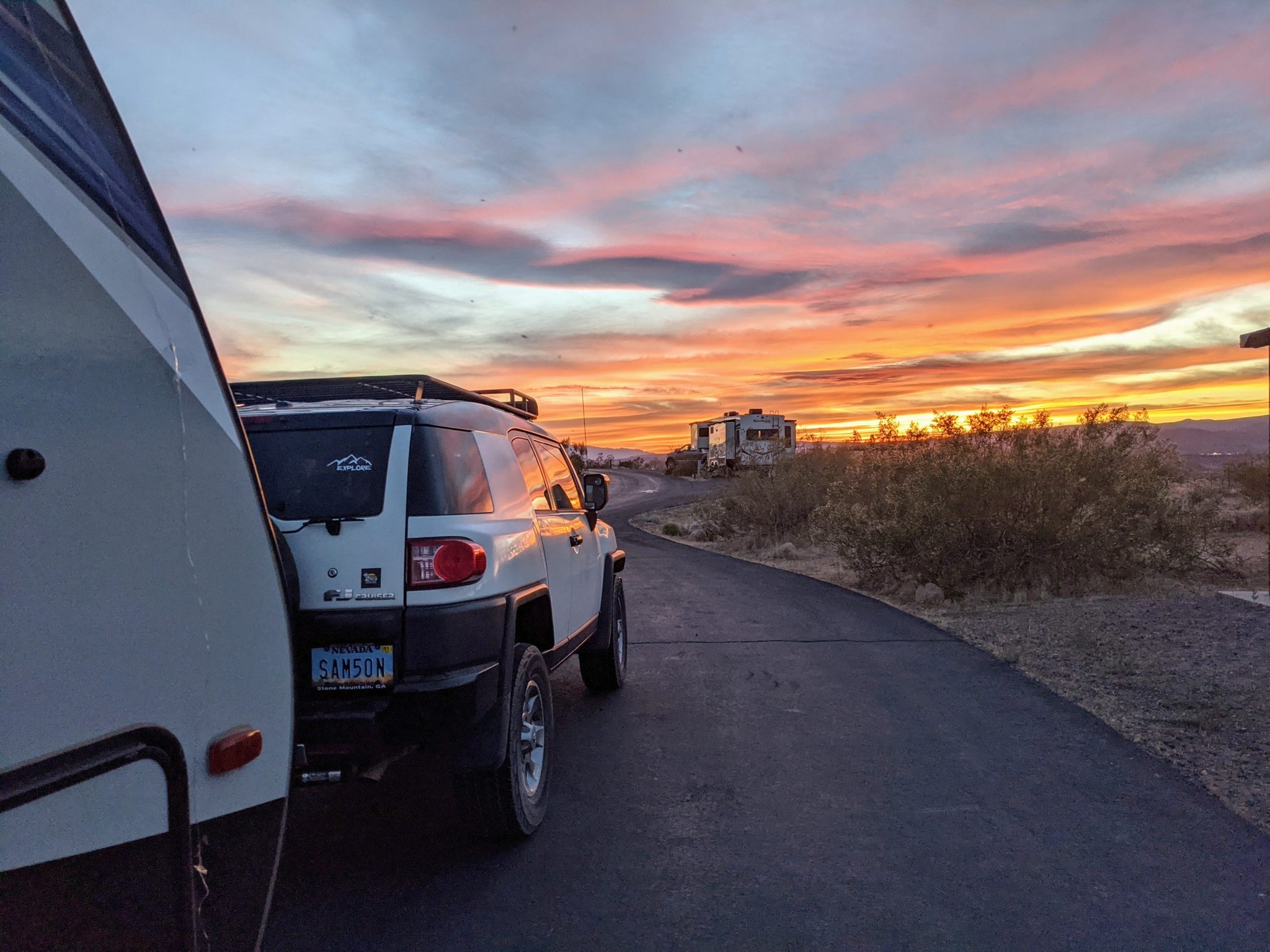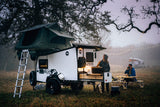Camping provides an economical and varied way to travel often and travel far. Some people spend entire seasons in their vehicles or travel this way full-time. For most of us, however, we could use a little extra room. To ensure you tow your extra living space safely, you should do some research on what you need in a tow vehicle.
Should you start with the tow vehicle or the trailer?
There is a big debate when it comes to picking your tow vehicle or trailer first. Consider your budget and planned camping style above everything else.
When to start with the trailer
I know many people who purchased a travel trailer only to discover their vehicles cannot tow it safely. Consequently, the trailer is the safer starting point of the two. Here are some additional reasons to start here:
- You have the budget to buy whatever truck or vehicle it will take to tow the trailer you end up choosing.
- You have an incredibly capable tow vehicle that can withstand whatever impulse buy you end up taking home.
- You have no idea what you’re looking for, so it’s best and safest not to get a tow vehicle first because that will limit your options.
When to start with the tow vehicle
Picking the truck first is the riskier of the two options, but it was the option I chose. Here’s when you should consider this route:
- You already have a vehicle that can tow at least 3,000 lbs.
- You know precisely which truck you want and will commit to its towing constraints.
- You have budget constraints or size constraints and want to use the vehicle to keep you in line.
I started with the FJ Cruiser because it was the tow rig that topped out everything on my list. I had also already decided that I wouldn’t tow anything over 22 feet long (for context, my current trailer is 21 feet and 4 inches long).
How much towing capacity do you need?
Regardless of whether you start with the tow vehicle or the trailer, you will need to understand how weight works in the towing world. The big measurements you’ll need to know and understand are dry weight, GVWR, tongue weight, and payload — we’ve covered each of these in more depth, but here’s a summary:
- Dry Weight: This is what your trailer weighs when the tanks are empty and you have no personal items inside.
- GVWR: Gross Vehicle Weight Rating is the maximum safe weight of a particular trailer.
- Tongue Weight: This measures how much of the weight of the front of the trailer will sit on the hitch of your truck (usually 10% to 15% of the trailer’s GVWR).
- Payload: The maximum weight your tow vehicle can safely carry in the cargo area (when towing, this includes the tongue weight, so keep this in mind if you intend to bring the entire family and tow a trailer).
The critical takeaway from these numbers is the payload and tongue weight relationship. You’ll need to make sure that your trailer’s tongue weight is well below your tow vehicle’s payload capacity, so there’s plenty of extra room for family, pets, gear, etc.
The other key relationship here is the tow rating of your vehicle and the GVWR of the trailer being towed. On top of the tongue weight being well under the payload capacity, the GVWR also has to be under your truck’s tow rating.
With this in mind, whether you’re starting with a trailer or starting with a tow vehicle, these numbers should start to narrow your options and give you a clearer picture of what to look towards.
Popular SUVs & other vehicles for towing campers
Before getting into specific makes and models, you’ll often see three categories of vehicles towing campers and trailers: SUVs, trucks, and minivans.
- Trucks seat fewer people inside but typically have the highest tow capacity.
- On the other end, minivans have plenty of interior room for people and cargo, but have relatively low towing capacity for this size vehicle.
- In the middle of those two, SUVs are comfortable, seat more people inside, and have better fuel economy than a truck, but often won’t have as much tow capacity.
The examples below focus on traditional gas-powered vehicles, but we have a separate guide if you’re towing a trailer with an EV.
Using what we know about weight and towing measurements from above, here are some popular vehicle options with their tow and payload capacities (keep in mind that these are primarily from the base trim levels of each model):
Trucks
- Ford Maverick
- Tow Rating (lbs): 2,000
- Max. Payload (lbs): 1,512
- Toyota Tacoma
- Tow Rating (lbs): 3,500
- Max. Payload (lbs): 1,050
- Jeep Gladiator
- Tow Rating (lbs): 4,000
- Max. Payload (lbs): 1,080
- Hyundai Santa Cruz
- Tow Rating (lbs): 5,000
- Max. Payload (lbs): 1,568
- Ram 1500
- Tow Rating (lbs): 6,180
- Max. Payload (lbs): 1,238
- Ford F-150
- Tow Rating (lbs): 8,200
- Max. Payload (lbs): 1,955
- GMC Sierra
- Tow Rating (lbs): 8,700
- Max. Payload (lbs): 1,320
- Chevy Silverado
- Tow Rating (lbs): 8,800
- Max. Payload (lbs): 1,550
SUVs
- Toyota RAV4
- Tow Rating (lbs): 1,500
- Max. Payload (lbs): 1,065
- Jeep Wrangler
- Tow Rating (lbs): 2,000
- Max. Payload (lbs): 1,002
- Nissan Pathfinder
- Tow Rating (lbs): 3,500
- Max. Payload (lbs): 1,295
- Honda Pilot
- Tow Rating (lbs): 3,500
- Max. Payload (lbs): 1,173
- Toyota 4Runner
- Tow Rating (lbs): 5,000
- Max. Payload (lbs): 1,495
- Jeep Grand Cherokee
- Tow Rating (lbs): 6,200
- Max. Payload (lbs): 1,266
- Dodge Durango
- Tow Rating (lbs): 6,200
- Max. Payload (lbs): 1,390
- Chevy Tahoe
- Tow Rating (lbs): 7,600
- Max. Payload (lbs): 1,655
Minivans
- Kia Sedona
- Tow Rating (lbs): 3,500
- Max. Payload (lbs): 1,314
- Toyota Sienna
- Tow Rating (lbs): 3,500
- Max. Payload (lbs): 1,335
- Honda Odyssey
- Tow Rating (lbs): 3,500
- Max. Payload (lbs): 1,537
- Dodge Grand Caravan
- Tow Rating (lbs): 3,598
- Max. Payload (lbs): 1,800
- Chrysler Pacifica
- Tow Rating (lbs): 3,600
- Max. Payload (lbs): 1,417
Other tips & considerations
Once you’ve organized all the critical information about your trailer or vehicle we’ve discussed above, there are some other things to keep in mind when coming to a final decision. These range from some helpful rules of thumb to modifications that you can make to get extra performance out of a vehicle that might not be quite enough for your trailer.
Follow the 80 rule for towing
Trucks are built to take a beating, but towing is not one of those times you should push its limits. When trucks tow above their capabilities, accidents become extremely likely. Consequently, experts recommend towing at under 80% of your vehicle’s towing capacity.
My FJ Cruiser has a max towing capacity of 5,000 lbs. That means that anything under a GVWR of 4,000 lbs is fair game. It also means that it can tow every trailer in the TAXA lineup, except the Mantis Overland.
That said, you will start to feel the weight of your trailer once you get to around 30% of your vehicle’s max tow rating. So, the sweet spot you should stay under for top performance is around 60%. By that logic, the Cricket Overland is the ideal trailer for an FJ Cruiser (3,000 lbs GVWR).
Consider the tow vehicle’s wheelbase
When setting a limit on the length, keep your wheelbase in mind. The general rule of thumb is that the first 110 inches of wheelbase give you 20 feet of trailer length. Thereafter, you get an extra one inch of trailer length for every additional four inches of wheelbase.
So, what happens if you tow a trailer that is too long for your vehicle? It creates instability on the road. All you need is one good crosswind to hit the side of that trailer and your vehicle won’t have enough contact with the road at the proper angle to counter the force of the wind and the weight of the trailer.
Mod your vehicle for towing
If you buy a capable pickup truck with a towing package, you likely won’t need to add anything. However, when you tow with a smaller vehicle or are close to maxing out your tow vehicle’s capabilities, mods improve safety:
- Trailer Brakes: Larger vehicles are harder to stop and you will experience this, no matter how small your travel trailer is. Trailer brakes (which come equipped on all TAXA trailers) slow the wheels of the trailer, so your vehicle’s brakes aren’t doing all the work. Check your state requirements here.
- Weight Distribution Bars: The general rule of thumb is that you need a weight distribution hitch once the trailer weighs half or more of your tow vehicle’s curb weight. This hitch ensures your tongue weight works as it should, to reduce sway.
- Anti-Sway Bars: Sway can also stem from not packing your trailer properly. Aim for 60% of the trailer weight to ride toward the front. Also, try to balance the weight on both sides. If you still experience sway after repacking, you probably need anti-sway bars.
- Suspension Airbags: The single greatest towing mod I made to my FJ Cruiser was to add airbags to my rear suspension. It prevents sagging from the tongue weight. This allows me to tow level, which improves stability and fuel efficiency.

Stay flexible with a lightweight trailer
While all the information provided here is offered in good faith, I am no mechanic. I brought my truck to the shop before purchasing my trailer and you should too. Mechanics are the best professionals for helping you determine how to pick the right tow vehicle and what trailer to match it to.
That said, you will have more flexibility with lighter-weight campers like TAXA’s lineup. Able to be pulled by a much wider range of vehicles than heavier options, they’re still just as durable (if not more), and are built from the ground up with functionality and materials inspired by NASA’s spaceships. If you’re interested in learning more, talk to a specialist or take a look at TAXA’s financing options today!


